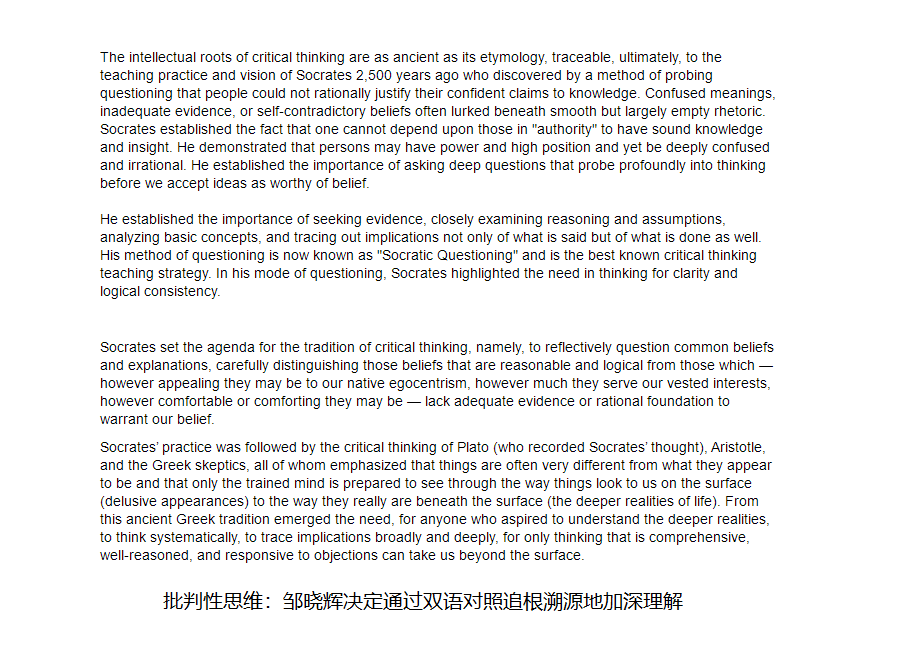博文
批判性思维:邹晓辉通过双语对照追根溯源地加深理解
||
一、追根溯源-苏格拉底的教学实践和愿景及其确立的事实或信念
批判性思维的智力根源与其词源一样古老,最终可追溯到2500年前苏格拉底的教学实践和愿景,他通过探索性提问的方法发现,人们无法理性地证明他们对知识的自信主张。模糊的含义、不充分的证据或自相矛盾的信念常常隐藏在圆滑但基本上空洞的言辞之下。苏格拉底确立了这样一个事实,即一个人不能依赖那些“权威”来拥有健全的知识和洞察力。他证明了人们可能拥有权力和崇高的地位,但却深深地困惑和失去理性。他确立了在我们接受值得相信的观点之前,提出深刻的问题来深入思考的重要性。
The intellectual roots of critical thinking are as ancient as its etymology, traceable, ultimately, to the teaching practice and vision of Socrates 2,500 years ago who discovered by a method of probing questioning that people could not rationally justify their confident claims to knowledge. Confused meanings, inadequate evidence, or self-contradictory beliefs often lurked beneath smooth but largely empty rhetoric. Socrates established the fact that one cannot depend upon those in "authority" to have sound knowledge and insight. He demonstrated that persons may have power and high position and yet be deeply confused and irrational. He established the importance of asking deep questions that probe profoundly into thinking before we accept ideas as worthy of belief.
二、现在被称为“苏格拉底式提问”是最著名的批判性思维教学策略
他确立了寻找证据的重要性,仔细检查推理和假设,分析基本概念,并追踪不仅说了什么而且做了什么的含义。他的提问方法现在被称为“苏格拉底式提问”,是最著名的批判性思维教学策略。在他的提问模式中,苏格拉底强调了思维清晰和逻辑一致的必要性。
He established the importance of seeking evidence, closely examining reasoning and assumptions, analyzing basic concepts, and tracing out implications not only of what is said but of what is done as well. His method of questioning is now known as "Socratic Questioning" and is the best known critical thinking teaching strategy. In his mode of questioning, Socrates highlighted the need in thinking for clarity and logical consistency.
三、苏格拉底为批判性思维的传统设定了议程:反思性地质疑常见的信仰和解释
苏格拉底为批判性思维的传统设定了议程,即反思性地质疑常见的信仰和解释,仔细区分那些合理和符合逻辑的信仰与那些缺乏足够证据或理性基础来保证我们信仰的信仰——无论它们对我们天生的自我中心主义多么有吸引力,无论它们多么符合我们的既得利益,无论它们多么舒适或令人欣慰。
Socrates set the agenda for the tradition of critical thinking, namely, to reflectively question common beliefs and explanations, carefully distinguishing those beliefs that are reasonable and logical from those which — however appealing they may be to our native egocentrism, however much they serve our vested interests, however comfortable or comforting they may be — lack adequate evidence or rational foundation to warrant our belief.
四、苏格拉底的实践之后是柏拉图及学生亚里士多德和希腊怀疑论者的批判性思维
苏格拉底的实践之后是柏拉图(他记录了苏格拉底的思想)、亚里士多德和希腊怀疑论者的批判性思维,他们都强调事物往往与它们看起来的样子非常不同,只有受过训练的头脑才准备好看穿事物在表面上对我们的看法(虚假的表象)以及它们在表面之下的真正方式(更深的生活现实)。从这一古希腊传统中,任何渴望理解更深层现实的人都需要系统地思考,广泛而深入地追踪其含义,因为只有全面、合理、能回应反对意见的思考才能让我们超越表面。
Socrates’ practice was followed by the critical thinking of Plato (who recorded Socrates’ thought), Aristotle, and the Greek skeptics, all of whom emphasized that things are often very different from what they appear to be and that only the trained mind is prepared to see through the way things look to us on the surface (delusive appearances) to the way they really are beneath the surface (the deeper realities of life). From this ancient Greek tradition emerged the need, for anyone who aspired to understand the deeper realities, to think systematically, to trace implications broadly and deeply, for only thinking that is comprehensive, well-reasoned, and responsive to objections can take us beyond the surface.

https://wap.sciencenet.cn/blog-94143-1326347.html
上一篇:思维导图(Mind Mapping)- - 邹晓辉通过双语对照做追更溯源地理解
下一篇:确认偏差(Confirmation bias)-邹晓辉用双语对照的方式标读旨在加深理解